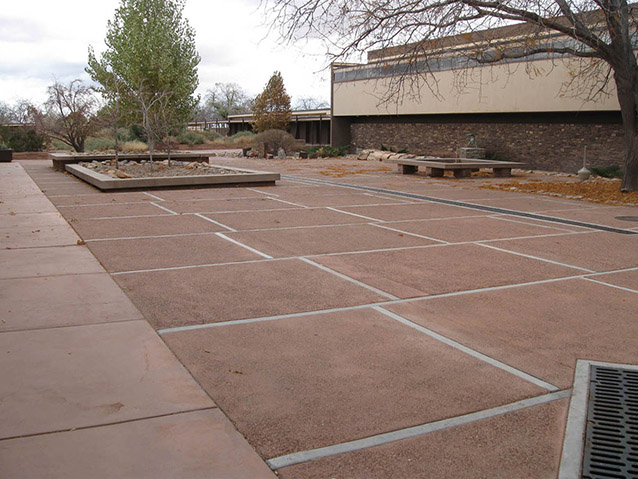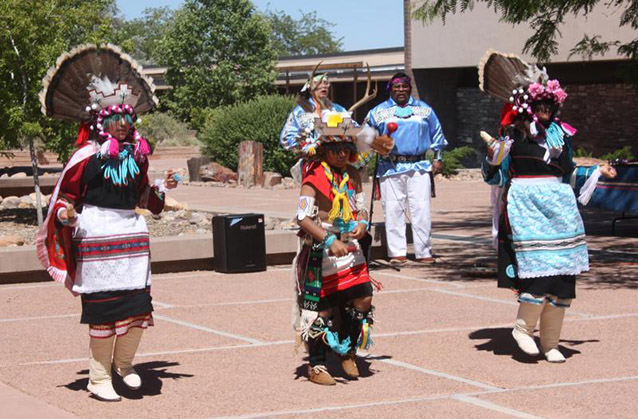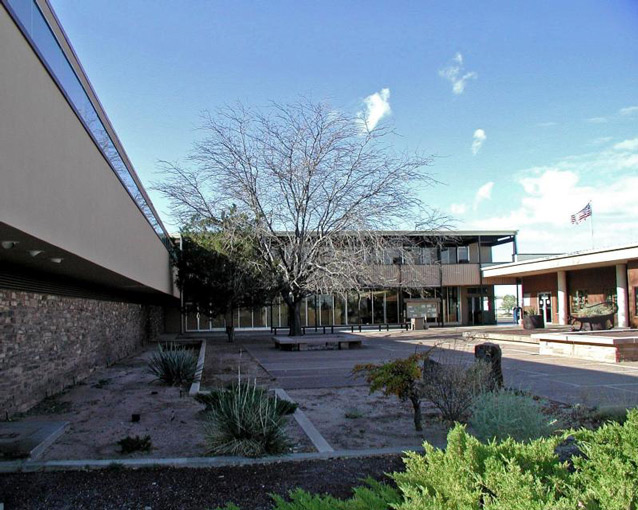The Painted Desert Community Complex is located within Arizona's Petrified Forest National Park. Petrified Forest is bounded by the Navajo Indian Reservation, by private lands, and by state trust lands. Less than 5 percent of the park is developed, which provides a relatively unimpaired experience for visitors.
The Painted Desert Community Complex is a self-contained, architect-designed desert community. In 1961, designer Richard Neutra explained that the houses should be grouped together around central courtyards because "they need each other's shelter."

NPS/J. Cowley
The Painted Desert Community Complex is located one mile from the Painted Desert. It encompasses 23 contributing buildings, sites, and structures that comprise a self-contained, architect-designed desert community. This complex was designed by Richard Neutra and Robert Alexander in 1958 to serve as the park’s headquarters, which includes administrative offices, maintenance facilities, visitor and resident services, employee housing, and a designed landscape. The 24-acre complex maintains its original form, footprint, spatial organization, and function, but most of the designed landscape features have nearly disappeared.
In their prospectus, “Homes for National Park Service Families on a Wind Swept Desert,” Neutra and Alexander divided the Painted Desert Community Complex into four areas: (1) the Commercial Area, including the Administration Building/Visitor Center, Apartment Wing, Fred Harvey Restaurant/Curio Store and Service Station, Central Plaza, and Entrance Station/Gatehouse; (2) the Industrial Area, which contains the Maintenance Building and Vehicle Storage Building; (3) the Recreation Area that includes the Community Building and School Building; and (4) the Residential Area, including the Teacherage Apartments, Residences, Carports, and Trailer Court Building with associated Trailer Court. The focal point of the complex lies at its center, where administrative and visitor services are oriented around a central plaza.

NPS
The Painted Desert Community Complex is exceptionally important and nationally significant for its association with Mission 66, a nationwide infrastructure improvement program implemented by the National Park Service from roughly 1956 until 1966. With the onset of World War II, the National Park Service was reduced to minimal staff and visitor services. All new construction projects halted and preventative maintenance was intentionally neglected.
Shortly after the war, however, tourism increased dramatically. Even though the demand for facilities and visitor services intensified, the NPS budget for equipment, materials, and personnel did not increase and NPS struggled to provide visitor services. To address these shortages, Mission 66 became a development strategy that would address long neglected repair, restoration, and new construction projects. It provided the NPS with the means to improve park infrastructure and increase visitor services in the mid-20th century.

NPS
The complex is also exceptionally important and nationally significant as an architecturally distinct example of Mission 66 design and representing a prominent work of Richard Neutra and Robert Alexander. As a result of the large number of Mission 66 construction projects, this program established a precedent for the “park service modern” style, which is a distinctive style of park architecture and the NPS adaptation of contemporary American modern architecture.
The Painted Desert Community Complex represents a unique and noteworthy example of Neutra and Alexander’s architectural design for the National Park Service. This complex signifies their distinct approach to modern windswept desert design, and it is one of only two properties that their architectural firm completed for the National Park Service as part of the Mission 66 initiative.
Quick Facts
- Cultural Landscape Type: Designed
- National Register Significance Level: National
- National Register Significance Criteria: A, C
- Period of Significance: 1961-1965
Landscape Links
Last updated: December 28, 2020
